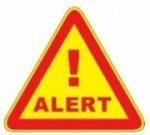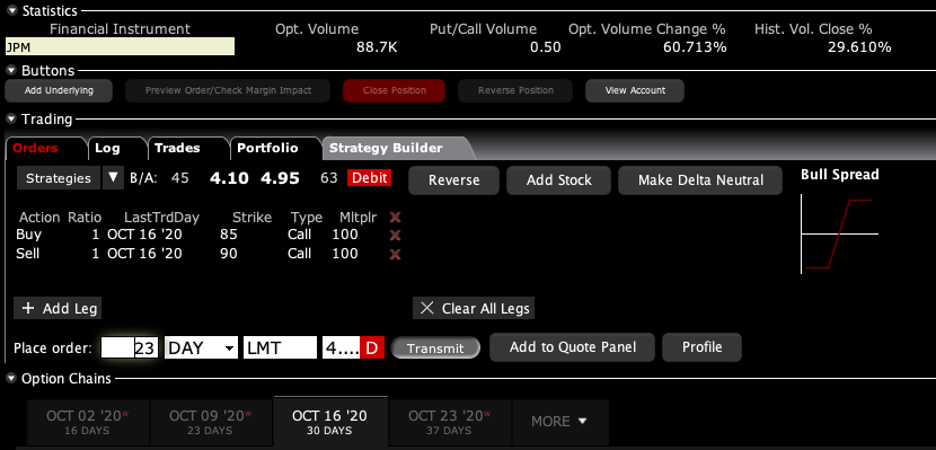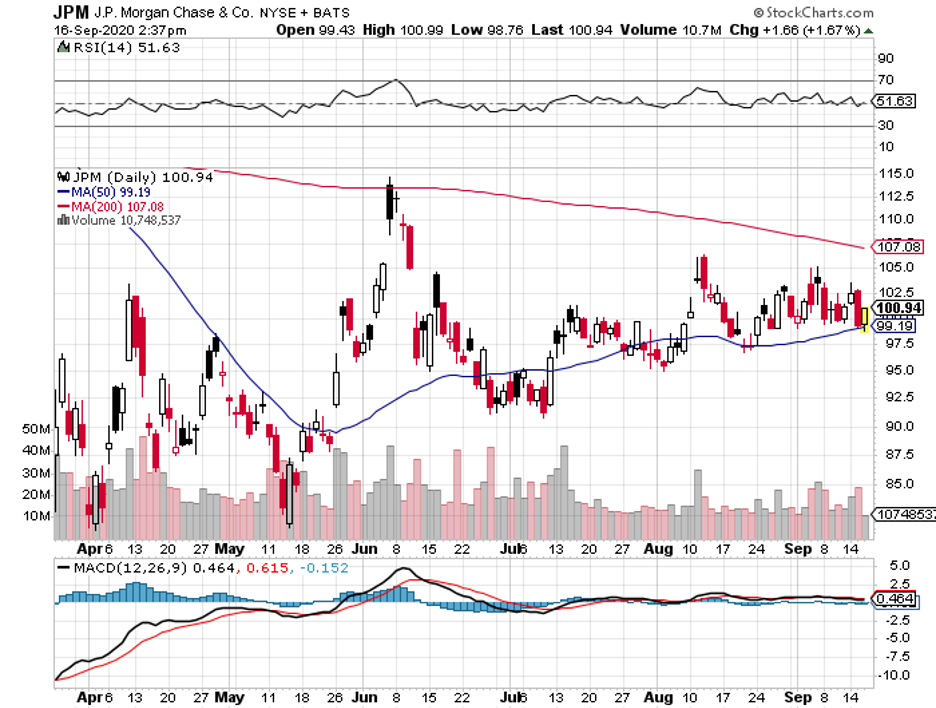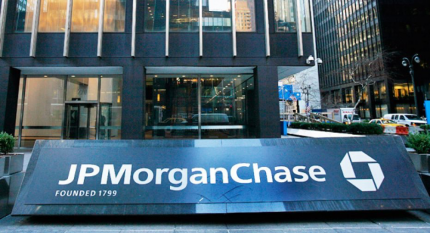When John identifies a strategic exit point, he will send you an alert with specific trade information as to what security to sell, when to sell it, and at what price. Most often, it will be to TAKE PROFITS, but, on rare occasions, it will be to exercise a STOP LOSS at a predetermined price to adhere to strict risk management discipline.
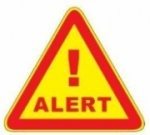
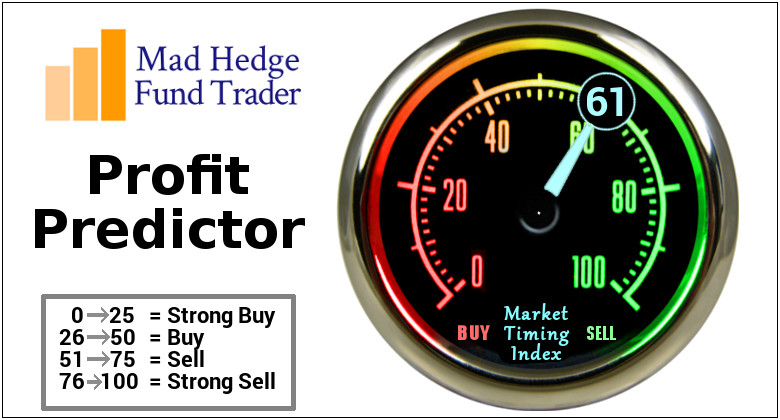
Trade Alert - (JPM) –BUY
BUY the JP Morgan (JPM) October 2020 $85-$90 in-the-money vertical Bull Call spread at $4.30 or best
Opening Trade
9-16-2020
expiration date: October 16, 2020
Portfolio weighting: 10%
Number of Contracts = 23 contracts
I am going to use the Fed’s announcements of no rate hikes until 2023 to dive back into JP Morgan Chase. Low rates are harmful to banks and the fact that it is now in the price is a positive.
I am therefore buying the JP Morgan (JPM) October 2020 $85-$90 in-the-money vertical Bull Call spread at $4.30 or best.
Don’t pay more than $4.70 or you will be chasing. Stock players should go ahead and buy the shares, which probably have a double in them over the next three years.
DO NOT USE MARKET ORDERS UNDER ANY CIRCUMSTANCES.
Simply enter your limit order, wait five minutes, and if you don’t get done, cancel your order and increase your bid by 10 cents with a second order.
Banks are the quality play in the market right now as it has the lowest price earnings multiple at 6X, and the best growth outlook in any economic recovery.
Banks now account for 15.5% of (SPY) earnings but are only 10% of stock market capitalization. Big tech gives us 13% of earnings but are a hefty 20% of market capitalization. Because of this, there is about to be a big rotation out of tech and into banks.
This cycle of COVID-19 infections is imminently going to peak out and start declining, at least for the short term.
As a result, I believe the core long FANG trade is long overdue for a break. Instead, I think we are about to witness a major rotation into domestic economic “recovery” stocks. Stocks will keep going up, but the leadership will change. Bonds and gold are also due for profit-taking.
There is no better domestic recovery play than the big banks. During a recovery, they will benefit from steeply rising interest rates, fewer defaults, yet continued government subsidies. The crown jewel of the American banking system in JP Morgan Chase Bank.
This is a bet that JP Morgan (JPM) would not trade below $90 by the October 16 option expiration day in 21 trading days.
Here are the specific trades you need to execute this position:
Buy 23 October 2020 (JPM) $85 calls at………….....………$16.00
Sell short 23 October 2020 (JPM) $90 calls at……..….…..$11.70
Net Cost:………..............……………..…….………..……….….....$4.30
Potential Profit: $5.00 - $4.30 = $0.70
(23 X 100 X $0.70) = $1,610, or 16.27% in 21 trading days.
The Bull Case for Banks
Banks have certainly been the red-headed stepchild of equity investment in 2020.
While technology shares have rocketed by two, three, and four-fold, banks have remained mire in the muck, down 35% on the year while the S&P 500 is up 6%.
However, all that is about to change.
Banks have become the call option on a US economic recovery. When the economic data runs hot, banks rally. When it’s cold, they sell-off. So, in recent months bank share prices have been flat-lining.
You have to now ask the question of when the data stay hot, how high will banks run?
There also is a huge sector rotation issue staring you in the face. Where would you rather put new money, stocks at all-time highs trading at ridiculous multiples, or a quality sector in the bargain basement? Big institutions have already decided what to do and are buying every dip.
Banks certainly took it on the nose with the onset of the pandemic. Interest rates went to zero and loan default rates soared, demanding a massive increase in loan loss provisions.
Much more stringent accounting rules also kicked in during January known as “Current Expected Credit Losses.” That requires banks to write off 100% of their losses immediately, rather than spread them out over a period of years.
Then in June, the Federal Reserve banned bank share buybacks and froze dividends to preserve capital in expectation of more loan defaults.
So what happens next?
For a start, fall down on your knees and thank Dodd-Frank, the Obama era financial regulation bill.
Banks carped for years that it unnecessarily and unfairly tied their hands by limiting leverage ratios to only 10:1. Morgan Stanley reached 40:1 going into the Great Recession and barely made it out alive, while ill-fated Lehman Brothers reached a suicidal 100:1 and didn’t.
That meant the banks went into the pandemic with the strongest balance sheets in decades. No financial crisis here.
Thanks to government efforts to bring the current Great Depression to a quick end, generous fees have been raining down on the banks from the numerous loan programs they are helping to implement.
And trading profits? You may have noticed that options trading volume is up a monster 95% so far in 2020 and increased by a positively meteoric 120% in August. That falls straight to the banks’ bottom lines. If you’re wondering why your online trading platform keeps crashing, that’s why.
I list below my favorite bank investments using the logic that during depressions, you want to buy Rolls Royces, Teslas, and Cadillacs at deep discounts, not Volkswagens, Fiats, or Trabants.
JP Morgan (JPM) – Is the crown jewel of the sector, with the best balance sheet and the strongest customers. It has over reserved for losses that are probably never going to happen, stowing away some $25 billion in the last quarter alone.
Morgan Stanley (MS) - Brokerage-oriented ones like Morgan Stanley (MS) and Goldman Sachs (GS) are benefiting the most from the explosion in stock and options trading. I’ll pick my former employer (MS), where I once accounted for 80% of equity division profits, as (GS) is still mired in the aftermath of the $5 billion Malaysia scandal.
Bank of America (BAC) - is another quality play with a fortress balance sheet.
Citigroup (C) – Is the leveraged play in the sector with a slightly weaker balance sheet and more aggressive marketing strategy. It seems like they’re always trying to catch up with (JPM). This week’s revelation of a surprise $900 million “operational loss” and the penalties to follow knocked 13% of the share price. This is the high volatility play in the sector.
And what about Wells Fargo (WFC), you may ask, the cheapest bank of all? Unfortunately, it still has to wear a hair suit because of its many regulatory transgressions, before, during, and after the financial crisis so I’ll give it a miss. Oh, and Warren Buffet is selling too.
To see how to enter this trade in your online platform, please look at the order ticket above, which I pulled off of Interactive Brokers.
If you are uncertain on how to execute an options spread, please watch my training video by clicking here.
The best execution can be had by placing your bid for the entire spread in the middle market and waiting for the market to come to you. The difference between the bid and the offer on these deep in-the-money spread trades can be enormous.
Don’t execute the legs individually or you will end up losing much of your profit. Spread pricing can be very volatile on expiration months farther out.
Keep in mind that these are ballpark prices at best. After the alerts go out, prices can be all over the map.

